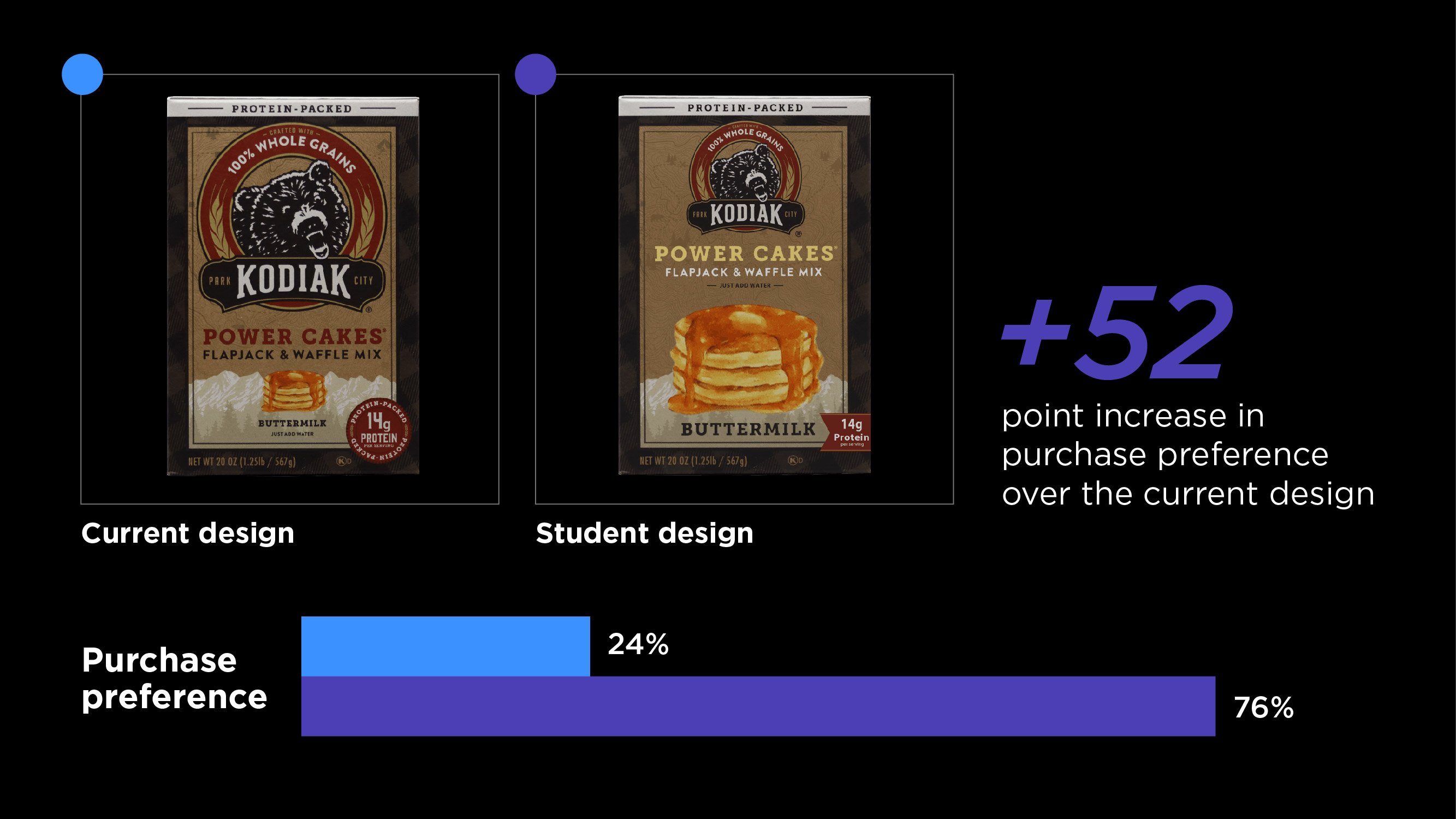For four years now, Designalytics has presented a challenge to students at the Pennsylvania College of Art & Design (PCAD). Guided by their instructor, Tom Newmaster, they are asked to develop updated packaging for a major brand that outperforms its current design, and each is given access to our empirically validated research and tools to help them do it.
This is a distinct advantage: in the consumer-packaged-goods (CPG) world, most of the robust consumer research occurs at the end of the process, after a new design has been selected. Designalytics offers high-quality data that’s pivotal early in the process, when it could still have a meaningful impact on creative development (e.g., setting the design strategy and iterating on initial concepts). From the jump, PCAD’s budding designers saw the edge this information provided. “Being able to look at consumer feedback on the current design helped a lot at the start,” recalled PCAD student Austin Taylor. “Just to know what you need to do, and what you might want to stay away from when creating your own.”
The students were given reasonable guardrails—for example, they couldn’t overhaul the brand’s logo or abandon a highly-distinctive asset. “Most art schools give assignments that are pretty pie-in-the-sky, where the student chooses something aligned with their interests and they develop everything. Good instructors make them flex their muscles in other ways,” noted Newsmaster, who is also a principal at FORCEpkg, a design and branding agency.
At the start of the project, the students selected an existing CPG brand, and Designalytics supplied them with in-depth data from our syndicated database showing how that brand’s current design performed with consumers relative to its top competitors. This included information about standout performance, communication, distinctive assets, element-level diagnostics, and more, which highlighted areas of relative strength and weakness for the brand.
Student Amanda Choong, who chose to redesign the package for Kodiak pancake mix, appreciated the ability to check her assumptions. “I felt like I knew the biggest areas for improvement, but I wanted to make decisions based on what consumers thought, instead of strictly my own opinion,” she said.
Taylor decided to redesign Michelob Ultra’s packaging, and noticed a trend as he was reviewing the design performance of competing brands. “Most of the time, consumers seemed to dislike designs that were very simple and minimalistic, especially when it came to beer packaging,” he remarked.


Armed with this trove of data and insight, Amanda, Austin, and their classmates each developed three initial concepts for their chosen brand. Designalytics tested these with more than 200 category buyers via our Versus design screening tool, which yielded highly-predictive quantitative data about whether the design would likely drive sales in market. “I thought it was very cool how I could get feedback from real consumers so quickly,” said Choong.
Not surprisingly, some of the students’ designs scored worse than (or on par with) the brand’s current design… which is exactly where most designers land at this point. Versus supports a progressive learning approach to design—testing to learn, that is, rather than to win—by providing access to hundreds of open-ended responses from consumers about why they preferred a specific design concept.
This aided in identifying potential issues to target, whether it be enhancing communication effectiveness, amping up product imagery, boosting text legibility, or addressing another area of potential improvement. “Using the research from Designalytics, I was able to confirm that consumers reacted positively to both making the image of the bear smaller and the pancakes larger,” Choong recalled. “I also learned that consumers loved the large red protein label instead of a simple "Protein packed" sentence on the box, which I did not anticipate.”
This kind of actionable feedback directly from consumers—the most important constituency in any design project—provided clear guidance. After the students refined their most promising design route using this feedback, Designalytics put each through 360 testing, a more comprehensive assessment that utilizes feedback from more than 600 category buyers.
The results varied, but several students improved upon their original designs, and a couple increased consumer purchase preference dramatically compared to the current design. For example, Amanda Choong’s Kodiak design boosted purchase preference: 76% of consumers preferred her design versus 24% for the current one. Austin Taylor’s Michelob Ultra redesign was also wildly successful, with 75% of consumers preferring his design to the currently on shelves (25%).


The students were blown away by seeing the impact that high-quality research at the right time can have. “I learned a lot of useful information about the package design process,” Taylor said. “Especially about the importance of thinking about the consumer’s point of view, and not just mine as a designer.”
“I loved this assignment and I would highly, highly recommend using the Designalytics process for rebranding, creating new designs, and even learning what you can improve on an existing design. I’m just very grateful to have had such a great learning opportunity,” commented Choong.
As in years past, Newmaster was pleased to see the change in students’ perspectives over the course of the project. “When it comes to packaging, it’s important that you’re making changes and improvements from an informed perspective, and I I think they really took that to heart.”
And this isn’t something that Newmaster only uses in the classroom, either—long tired of traditional research solutions, he has been using Designalytics in his own package design work. “I’ve recommended Designalytics’ tools for my clients. It’s fast, affordable, reliable… it’s like, why would we do it any other way?” he said.
Designalytics offers its designer-friendly research tools for use by creative agencies. If you’re interested, contact us.




